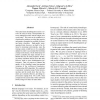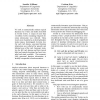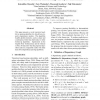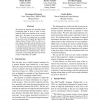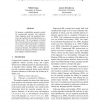ACL
2012
12 years 1 months ago
2012
The named entity disambiguation task is to resolve the many-to-many correspondence between ambiguous names and the unique realworld entity. This task can be modeled as a classifi...
ACL
2012
12 years 1 months ago
2012
We present a hierarchical chunk-to-string translation model, which can be seen as a compromise between the hierarchical phrasebased model and the tree-to-string model, to combine ...
ACL
2012
12 years 1 months ago
2012
In this paper, we present a new method for learning to finding translations and transliterations on the Web for a given term. The approach involves using a small set of terms and ...
ACL
2012
12 years 1 months ago
2012
We present a novel algorithm for multilingual dependency parsing that uses annotations from a diverse set of source languages to parse a new unannotated language. Our motivation i...
ACL
2012
12 years 1 months ago
2012
We seek to automatically estimate typical durations for events and habits described in Twitter tweets. A corpus of more than 14 million tweets containing temporal duration informa...
ACL
2012
12 years 1 months ago
2012
This paper presents a comparative study of target dependency structures yielded by several state-of-the-art linguistic parsers. Our approach is to measure the impact of these noni...
ACL
2012
12 years 1 months ago
2012
In this paper we show how to train statistical machine translation systems on reallife tasks using only non-parallel monolingual data from two languages. We present a modificatio...
ACL
2012
12 years 1 months ago
2012
This paper presents a novel top-down headdriven parsing algorithm for data-driven projective dependency analysis. This algorithm handles global structures, such as clause and coor...
ACL
2012
12 years 1 months ago
2012
We present an approach for detecting salient (important) dates in texts in order to automatically build event timelines from a search query (e.g. the name of an event or person, e...
ACL
2012
12 years 1 months ago
2012
We propose a probabilistic generative model for unsupervised semantic role induction, which integrates local role assignment decisions and a global role ordering decision in a uni...
